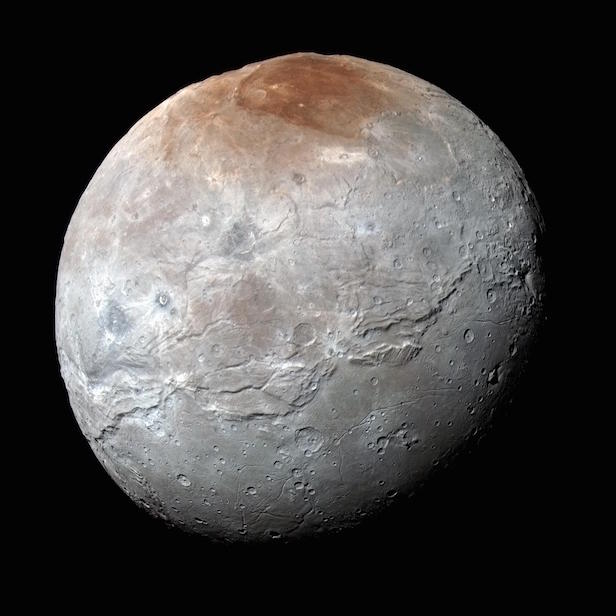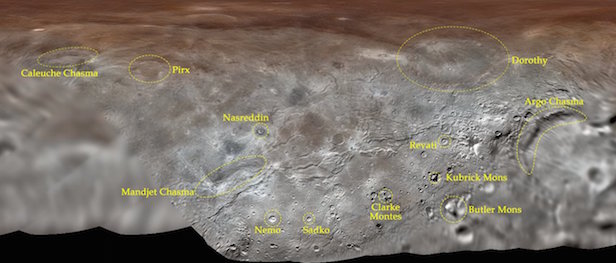Pluto’s moon gets its first surface feature names
Almost three years after NASA’s New Horizons mission flew past Charon, the International Astronomical Union (IAU) has named some of its landmarks

Charon is the largest of Pluto’s five moons, and is also roughly half the size of Pluto. Image credit: NASA/JHUAPL/SwRI
Pluto’s largest moon, Charon, has been designated with its first official surface feature names, thanks to the International Astronomy Union (IAU). Crevices, craters and valleys now honour legendary explorers and visionaries, whether they are real or fictitious. NASA’s New Horizons team, which handled the spacecraft’s flyby of Pluto and Charon in 2015, put forward a dozen names that were approved by the body’s Working Group for Planetary System Nomenclature.
Charon is considered to be one of the larger bodies in the region beyond Neptune composed of primordial asteroids, more commonly known as the Kuiper Belt. Charon also has a wealth of geological features, including numerous amounts of craters, similar to what is seen on other moons in the Solar System. It was decided by IAU that it was time to assign some official names for such features.
The New Horizons team were the driving force behind the approval of these new names. This team includes the Principal Investigator Alan Stern, as well as science team members Ross Beyer, Will Grundy, William McKinnon, Jeff Moore, Cathy Olkin, Paul Schenk, Amanda Zangari and Mark Showalter, the group’s chairman and liaison to the IAU. Most of the ideas for these names were gathered during the Our Pluto online public naming campaign in 2015.
The names that IAU gave the thumbs up to embraces a variety of recommendations that the New Horizons team received from people around the globe during the aforementioned campaign. Regardless of the New Horizons efforts, members of the public all over the world still gave continuously suggestions for interesting names.
With the hugely successful exploration mission New Horizons in mind, a mission that has yet again pushed the boundaries of space exploration, it was decided that the features should pay tribute to the never-ending spirit of human exploration. These features honour travellers, explorers, scientists, pioneering journeys and mysterious destinations. Rita Schulz, chair of the IAU Working Group of Planetary System Nomenclature, says, “I am pleased that the features on Charon have been named with international spirit.”

The first official set of features names are all based upon the concept of exploration and adventure. NASA/JHUAPL/SwRI
Here is the list of feature names, based on literature and mythology of exploration:
Argo Chasma is named after the ship sailed by Jason and the Argonauts during their search for the Golden Fleece, written in the Latin poem Argonautica.
Butler Mons honours of Octavia E. Butler, the first science fiction writer to win a MacArthur fellowship, and whose Xenogenesis trilogy humankind’s departure and eventual return to Earth.
Caleuche Chasma is the name of the mythological ghost ship that explored the seas around the small island of Chiloé, off the coast of Chile. Legend has it that Caleuche collects the dead from the coastline, who then stay on the ship forever.
Clarke Montes honours Sir Arthur C. Clarke, the famous science fiction writer and futurist, whose popular work depicts creative and fascinating space exploration scenarios.
Dorothy Crater is named after the protagonist of the prominent series of children’s novels by L. Frank Baum. These stories details Dorothy Gale’s travels and adventures through the magical world of Oz.
Kubrick Mons honours the film director Stanley Kubrick. His work on 2001: A Space Odyssey tells a magnificent story of humanity’s evolution from tool-using hominids to space exploration and beyond.
Mandjet Chasma is named after one of the boats in ancient Egyptian mythology. This boat carried the sun god Ra (Re) across the sky each day, which makes it one of the earliest mythological examples of a vessel of space travel.
Nasreddin Crater bares the name of a popular protagonist that has featured in thousands of humorous folktales told across the Middle East, southern Europe and parts of Asia.
Nemo Crater is named after the captain of the submarine Nautilus. This submarine features in Jules Verne’s novels Twenty Thousand Leagues Under the Sea (1870) and The Mysterious Island (1874).
Pirx Crater takes the name of the main character in the series of short stories written by Stanislaw Lem, describing journeys between Earth, Moon and Mars.
Revati Crater is named after the main character of a Hindu narrative Mahabharata, which is regarded as the oldest concept of time travel, dating back to circa 400 BC.
Sadko Crater honours the adventurer who travelled to the bottom of the sea in the medieval Russian epic Bylina.
Keep up to date with the latest news in All About Space – available every month for just £4.99. Get 5 issues of All About Space for just £5 with our latest offer!





